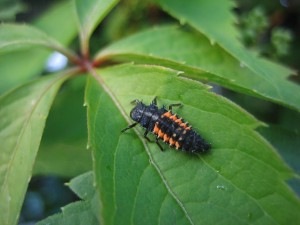It’s been fascinating seeing “survival of the fittest” in action in our garden this year.
We dug a pond last year and though a little empty over the winter, it was thriving with life this year. We started the spring a little concerned with the amount of weed that had grown. Then got slightly concerned that the four-or-five pond snails that we’d added had multiplied at an exponential rate. And then – cue much excitement – frogspawn came!
Now, I’m not entirely sure what eats what, but the weed disappeared. Did the tadpoles eat it? Did the snails eat it? Did something else eat it?
Anyway, then the tadpoles were, finally, reduced to about 15 tiny frogs. Oh, and the snail population has…well, I’m not sure by what means, but it’s dramatic growth suddenly ground to a halt. Which is just as well because, otherwise, Swindon would be overrun with gastropods1.
Then there was the blackfly, which appeared out of nowhere and have never been a problem before. Soon followed by these:

Which we had to look up, but which turn out to be…ladybird lavae. It may be that we’ve just not been looking for them before but when we looked carefully there seemed to be loads of them.
And what eats blackfly? Well: “The aphid’s enemies include hoverflies, ladybirds, lacewings and birds.” (thanks Garden Action!)
Which explains these weird, alien, translucent bugs too:

Yup – we had to look those up too, but that’s a hoverfly larvae!
Where they came from, if they deliberately came from anywhere, I don’t know, but shortly after they appeared the blackfly magically disappeared.
I’d heard about this kind of thing happening over many years with larger animals, but I didn’t realise that populations could boom and bust within less than a season.
Nature’s work continues to fascinate. There’s more to gardening than just growing plants you know. There’s so much to see, get experience and get involved in – even for a thirty-something!
- I should point out that a gastropod is not a new type of high-class cafe! ↩